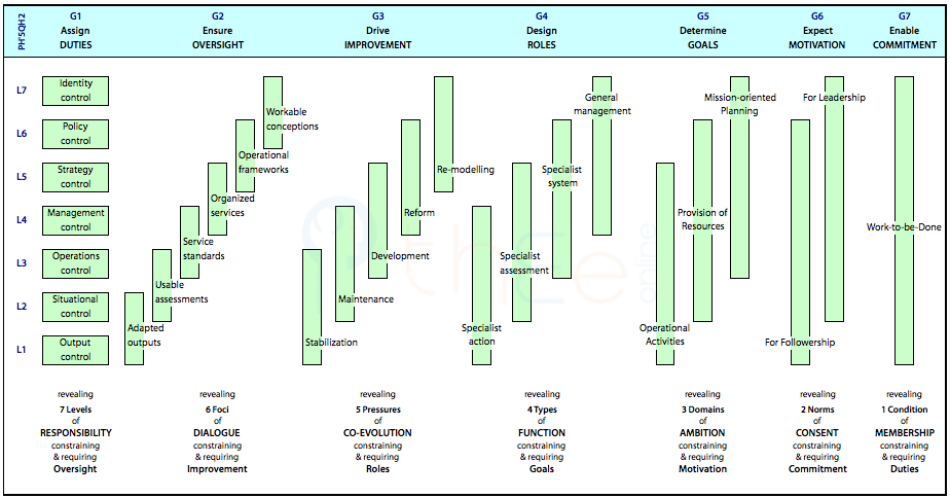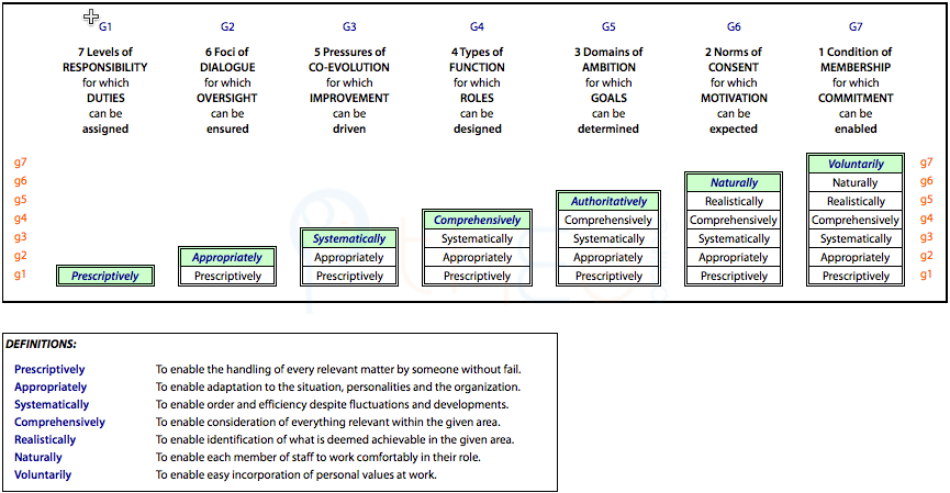Review
There are some changes from the original publication in 1990, and the overall theme is different. My fuller picture of the Taxonomy is responsible for most of the improvements. The previous formulations had at times confused work-as-doing with work-as-responsibility. The most significant changes are found in and .
Recognizing that there are that align with personal capability is surely one of the great discoveries of the 20th century. But as this inquiry shows, the original discoveries of Jaques and Brown were only the first stage. Their findings need to be expanded in three directions:
- to engage with other aspects of work and its organisation like decision-making and use of purposes, which means introducing additional perspectives;
- to cover work-responsibilities and capabilities not previously considered, which means recognizing work and organisation in other discrete domains like academia and societal institutions; and
- to engage with other aspects of psychosocial life, which means locating work in the Taxonomy and appreciating the relevance of matters like change, language, personal identity and more.
Differentiation and Integration
The needs to be differentiated in order for duties to be formulated and assigned. However, this differentiation must be managed. The Structural Hierarchy provides for progressive integration as shown in the Table below. The Table can be read either from bottom up or top down.
| G | What is Organised | Function | Manifestation |
|---|---|---|---|
| G7 | Enable commitment voluntarily |
For everyone to be identified with the values of the organization. | 1 Condition of Membership
(Heptad) |
| G6 | Expect motivation naturally |
For staff to lead and follow management requirements in accord with their position. | 2 Norms of
Consent
(Hexads) |
| G5 | Determine goals realistically |
For functional structures to mesh and produce desired achievements. | 3 Domains of
Ambition
(Pentads) |
| G4 | Design roles comprehensively |
For work areas to be demarcated, owned and expertly handled. | 4 Types of
Function
(Tetrads) |
| G3 | Drive systematically |
For changes to occur without disrupting operations and existing initiatives. | 5 Pressures of
Coevolution
(Triads) |
| G2 | Ensure appropriately |
For both the overall view and particular details to influence the handling of situations. | 6 Foci of
Dialogue
(Dyads) |
| G1 | Assign prescriptively |
For clarity to be shared about the exact nature of the work that has to be done. | 7 Levels of Responsibility(Monads) |
to the for the mission (), which is the ultimate foundation for all organisation and management, calls for recognition of a basic amongst staff.
This must be differentiated by THEE so as to clarify and (): despite the inevitable loss of equality. Once this occurs, progressive integration becomes essential. It is first necessary to establish viable machinery for regular () with cooperative dialogue. Then () must be driven in ways that minimize disruption. Ensuring competence in all requires the comprehensive identification and management of () including general management. Finally, () need to be determined in accord with ambitions.
The whole system depends on that is natural and expressed via leading and following (), and a personal () that requires active facilitation.
See full graphic layout below.
Better viewing: Use browser zoom if needed.

Coherence
There is a structural coherence revealed by the set of all possible adjacent groupings, each of which depends on the others. This reduces, possibly resolves, the uncertainty in earlier research about the number of possible in an organization. Coherence is further evidence by considering the qualifiers. Each qualifier not only characterizes the Grouping as a whole, but also provides details of the gradation of responsibilities within each Group in that Grouping.
See details below.
Better viewing: Use browser zoom if needed.

The design of needs to be analysed and understood quite separately from issues of . See a comparison here.
More
- How management's confidence and anxiety unfolds.
- Qualities of odd- and even levels.
- Compare closely associated frameworks seemingly far apart in the Taxonomy:
& . - Review the tensions in .
- Check-list of responsibilities at each .
OR move to the next section:
- Explore socio-emotional dynamics of participating within organizations.
Originally posted: 26-Mar-2014